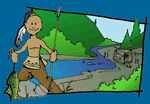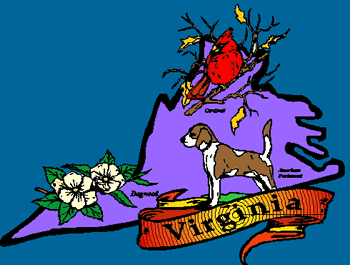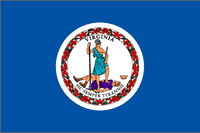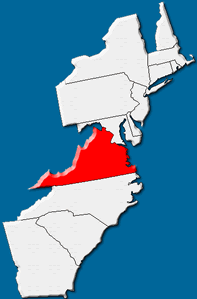


Geography and Landforms:
Virginia is made up of four distinct geographical regions: the Tidewater, Piedmont, Valley and TransAllegheny areas. The Tidewater is a level area of coastal plain which includes four great rivers: the Potomac, the Rappahannock, the York and the James, all of which empty into the Chesapeake Bay. The Piedmont is a rolling plateau region between the Tidewater and the Blue Ridge Mountains. The Great Valley lies between the Blue Ridge and Allegheny mountains, and the TransAllegheny area includes portions of the Blue Ridge and Appalachian mountain ranges.
|
 History:
Sir Humphrey Gilbert and Sir Walter Raleigh were the first Europeans to attempt settlements in the area of Virginia beginning in 1606. The first 144 settlers left England in December of that year in the "Susan Constant," the "Godspeed," and the "Discovery" and arrived at Jamestown on May 13, 1607. At that time, the Protestant government of England thought it would be important to establish a strong colony in the "New World" to prevent the land from being taken entirely by the Roman Catholic government of Spain.
|
 Economy:
The years following the Civil War were difficult for the state of Virginia, and interrupted what had been a strong economy from the earliest years of colonization. However, by 1930, the per capita income for the population of Virginia was above the national average.
|
 First Inhabitants:
Native people have inhabited the region now known as Virginia for thousands of years. Archaeologists believe that between 3,000 and 1,000 years ago, people first began to settle into villages. It was also about this time that people first began to clear sections of land by burning so that edible plants would continue to grow in those areas each year. We would consider this the earliest examples of farming. For example, we know these people ate sunflowers, ragweed, sumpweed, squash, gourds, and greens. They hunted deer, black bear, turkey, squirrel, rabbits, beaver, otter, muskrat and water birds. Particularly in the Coastal Plain Region of Virginia, the people fished for shad, herring, rockfish, and sturgeon. Oysters, clams, crabs and turtles were plentiful.
|
Books Related To VirginiaBlood on the River: James Town, 1607 - Elisa Carbone Deep Down Popular - Phoebe Stone Ghost Girl - Delia Ray Give Me Liberty - Laura Elliot John's Story, 1775 - Joan Lowery Nixon Lady Margaret's Ghost - Elizabeth McDavid Jones Light Years - Tammar Stein Miz Berlin Walks - Jane Yolen O is for Old Dominion: A Virginia Alphabet - Pamela Duncan Edwards Park's Quest - Katherine Paterson The Search for Belle Prater - Ruth White Shades of Gray - Carolyn Reeder Taking Liberty: The Story of Oney Judge, George Washington's Runaway Slave - Ann Rinaldi Time's Memory - Julius Lester Who's Saying What in Jamestown, Thomas Savage? - Jean Fritz With the Might of Angels - Andrea Davis Pinkney |
Famous Citizens:
|
| Capital: | Richmond |
| Entered Union: | June 25, 1788 |
| Population: | 8,326,289 |
| Area | 42,774 |
| Bird | Cardinal |
| Flower | American Dogwood |
| Nickname: | Old Dominion State, Mother State |
| Governor | Terry McAuliffe |
Places to Visit in Virginia: (Click the links to learn more.)
|



